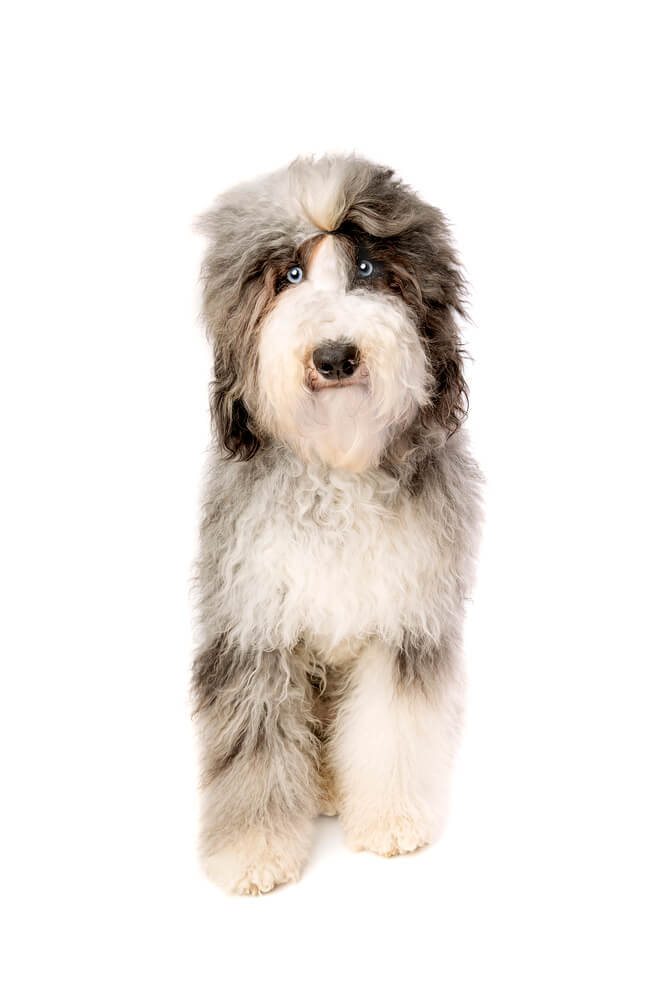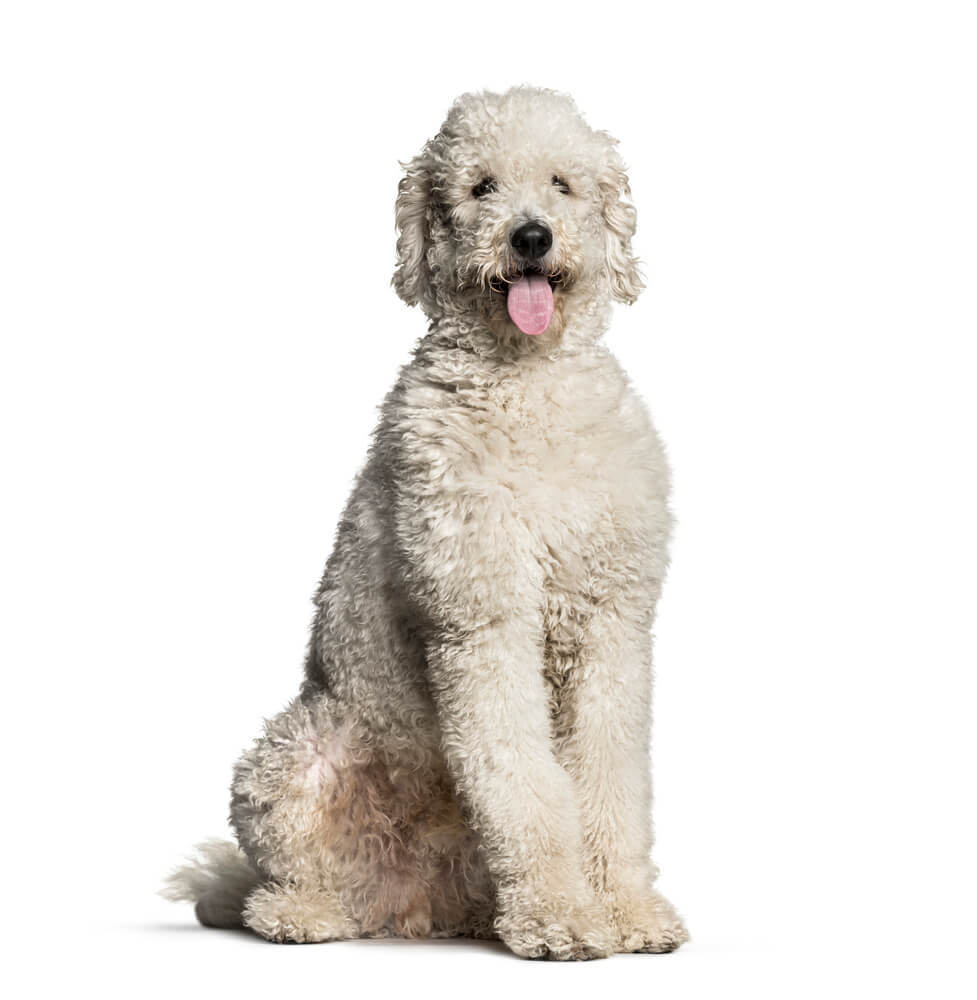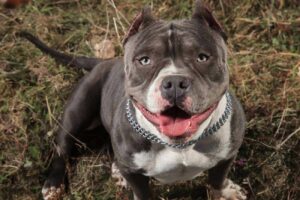Doodle dog breeds have become popular over the past decade or so.
Breeders originally started breeding this hybrid mix of a poodle and another breed to create a dog breed with coats that were more hypoallergenic.
Two of the more popular breeds of Doodle dogs are the Sheepadoodle and the Labradoodle.
There are similarities and differences in both hybrid breeds, so how do know which is better for your family and lifestyle?
That's what we are here to find out!
The simple answer is, you need to learn about each one in order to make a more informed choice.
Before you go to pick out that Labradoodle or Sheepadoodle pup, take the time to find out their traits, temperament, and needs.
Some Doodles do better with large active families and others like a more laid-back environment. Some will need to be more active, and some will be more high maintenance.
Let's compare these two Doodle's side by side.
What Does a Sheepadoodle Look Like?

Sheepadoodles have gone by a few names: Sheepdoodle, Sheepdogpoo, and Sheeppoo.
Their coats tend to be a mixture of black and white, a chocolate brown and white, black, or solid gray. They have coats that are dense and long and their fur is typically wavy. However, there are some who have straight or curly coats.
Sheepadoodles can have a domed head shape or a face that is more squarish. They also have very fluffy paws and faces, and big floppy ears. Their bodies are proportioned well and are muscular and strong. Sheepadoodles are classed as working breed dogs because of their herding tendencies.
When it comes to size, it can vary depending on the size of the Poodle parent. However, the majority of Sheepadoodles are of a standard size of between 16 to 22 inches tall and can weigh between 60 to 80 pounds.
What Does a Labradoodle Look Like?

Labradoodle coats come in a variety of colors: black, cream, tan and black, blue brindle, caramel, red, golden apricot, or a combination of the colors mentioned. Their coats can be wavy, wiry, fleece-like, curly, or wooly.
They have big floppy ears, a fuzzy face and muzzle, a compact chest, and expressive eyes that are wide-set. Their bodies are muscular and strong with a gait that is confident.
Size can vary with Labradoodles, depending on what size their Poodle parent was. You have 3 sizes:
- Standard size is between 22 to 24 inches tall for male dogs and 21 to 23 inches for female dogs. Weight can fall between 50 to 65 pounds
- Medium size males are between 18 to 20 inches tall and females between 17 to 19 inches. Weight ranges between 30 to 45 pounds
- Miniature size falls between 14 to 16 inches for males and females, and they can weigh from 15 to 25 pounds.
What is the Difference between a Sheepadoodle and a Labradoodle?
One of the more noticeable differences between these two is size.
Sheepadoodles tend to be bigger than Labradoodles in both height and weight.
Sheepadoodles
- Height: 16 to 27 inches
- Weight: 55 to 85 pounds
- Lifespan: 12 to 15 years
- Shedding: Low shedding, hypoallergenic
- Color variations: Combinations of white, gray, and black, and chocolate brown
- Temperament: Intelligent, protective, loving, and goofy
- Cost: $1,000 to $ 3,000
Labradoodles
- Height: 22 to 24 inches
- Weight: 50 to 80 pounds
- Lifespan: 12 to 14 years
- Shedding: Low shedding, hypoallergenic
- Color variations: Wide variety of colors and color combinations
- Temperament: Smart, sociable, energetic, and friendly
- Cost: $1,500 to $2,000
Goldendoodle vs Sheepadoodle: Similarities and Differences
Let's compare these two doodle fluff balls side-by-side.
History
The history of the hybrid Sheepadoodle is a bit murky. While they may have naturally existed for quite some time, it wasn't until the 1980's that the Sheepadoodle became popular because of their hypoallergenic coats.
However, the U.S. Military experimented with this crossbreed in the 1960s to use as working dogs.
Their Old English Sheepdog ancestors were bred as far back as the 1700s in the west of England.
Labradoodles were bred as far back as 1989, when breeder for the Royal Guide Dogs Association of Australia, Wally Conron, was looking to create a hybrid of a guide dog that was hypoallergenic.
This cross between a Poodle and a Labrador Retriever was a success, however, once it became public, many breeders started to breed Labradoodles.
It's thought that this cross breed could have existed as far back as 1955 because a Labradoodle is mentioned in a book published at that time by Sir Donald Campbell called Into the Water Barrier.
Temperaments
Sheepadoodles are considered to be very adaptable and overall friendly dogs. They have the traits of intelligence and gentleness from their Old English Sheepdog parent.
They can be playful, affectionate, energetic, and quiet. They tend to get along well with family, children, other pets, and even strangers.
They don't tolerate being alone as well as other breeds because of their close attachment to family members. They can also adapt to living in smaller homes, like apartments.
Labradoodles are sociable, intelligent, and tend to get on well with everyone, including strangers. They are affectionate with family members, children, and other pets. Labradoodles always want to play and can be quite energetic. They are great swimmers and love water.
Which Doodle Is the Calmest?
Of the two breeds, the Sheepadoodle is the calmer of the two. Labradoodles are more excitable, whereas a Sheepadoodle has no problem lounging around with family members.
Cost
A Sheepadoodle puppy can cost you anywhere from $1,000 to $3,000 when bought from a reputable breeder. You may come across a Sheepadoodle for about $500 from a shelter, however, this is very rare.
A Labradoodle puppy can cost an average of between $1,500-$2,000 when purchased from a reputable breeder. Like the Sheepadoodle, you may get lucky and find one in a local shelter for much less.
Grooming
While both the Sheepadoodle and Labradoodle are known to have hypoallergenic and lower shedding coats, no dog breed is fully hypoallergenic. It comes down to the coat. The tighter the curl, the less shedding there will be.
Do Sheepadoodle Dogs Shed?
It can seem like a Sheepadoodle doesn't shed at all, until you brush them. Because of their curly coats, shed fur tends to get stuck. This is why they need to be brushed regularly.
Sheepadoodles will need to be groomed about every 8 weeks. They should be brushed once a day with a de-shedding brush, but you can get away with brushing them 2 to 3 times a week to keep their coats from becoming matted (see video below).
They tend to need a bath once a month, depending on what they get themselves into outdoors. Their long coats are great for the winter weather and, while they do alright in the summer, it is better to keep their coats a bit shorter.
Labradoodle grooming will depend on what type of coat they have, which can range from short and curly to straight and long. While daily brushing with a de-shedding brush is recommended, they should be brushed at least once or twice a week, and properly groomed every 6 to 8 weeks. They tend to not need to be bathed often.
Average Lifespan
Both breeds are fairly healthy and have similar lifespans when well cared for.
Sheepadoodles can live for an average of 12 to 15 years, and Labradoodles for 12 to 14 years. Both need to be kept at a healthy weight.
Trainability
Both of these crossbreeds are highly intelligent, but which is easier to train. Most will say the Labradoodle, due to its parentage.
Are Sheepadoodles Easy To Train?
Sheepadoodles are quick learners. They get their intelligence from their Poodle parent, and Poodles are 2nd on the list of intelligent dogs. They are also eager to please, which they get from their Old English Sheepdog parent.
However, the Sheepdog breed isn't as intelligent. So it will depend on which parent they take after when it comes to intelligence.
This is why it's best to get your Sheepadoodle from a reputable breeder.
Labradoodles come from a mix of two intelligent breeds. They are also eager to please and they love learning new things. They do have a bit of a mischievous side but proper training will help with that. The main thing to remember, with both Doodle breeds, is to start training at an early age.
Barking
Do Sheepadoodles Bark a Lot?
Sheepadoodles are gentle giants and quieter by nature. While they love to socialize, they tend not to bark when meeting someone new or meeting a new pet. You may run into a problem though if you leave them alone for too long.
They become very attached to their humans and can get separation anxiety, which may result in barking.
Labradoodles are considered to be moderate barkers but tend to bark for a reason, and that reason is to alert you to something, such as someone walking by the home, to protect you, loud noises, boredom, excitement, and being left alone.
If they haven't been trained as pups to not bark, then they will bark more often.
Exercise Needs
Sheepadoodles can be prone to gaining weight, which means they need daily walks and exercise. It's not just physical exercise they need.
They also need mental stimulation or they could resort to destructive behavior if they are bored, especially as puppies.
Labradoodles like to have space to run and will need about 30 minutes to an hour a day for exercise. They do well in homes with a yard to run in so that they can burn off some of their active energy.
They make good companions for joggers and hikers. Like the Sheepadoodle, they need mental stimulation as well, or they may resort to destructive behavior.
Behavior with Small Children and Other Pets
Sheepadoodles are known for their herding instincts and they enjoy being around children.
They show a lot of affection, patience, and are even-tempered. They will playfully “nip” at children's heels to “herd” them. Sheepadoodles will get on well with other pets as long as you gradually introduce them.
This should be done at an early age and in a calm setting.
Labradoodles are also a great companion to children because of their gentle and affectionate nature.
However, you need to watch them around smaller children because they can be excitable and may accidentally knock a small child down. They will also get along with other pets if trained and introduced properly.
Saying that you should teach children how to interact with dogs properly to avoid mishaps.
Health Problems
Sheepadoodles, while pretty healthy, can be predisposed to some of the health problems of their parent breeds, such as:
- Hip dislocation or dysplasia
- Eye diseases, such as cataracts, glaucoma, and Retinal Atrophy, which may lead to blindness
- Luxating Patella (wobbly knees)
- Gastric dilatation-volvulus (Bloat)
- Addison's Disease
- Skin Disorders
The same goes for Labradoodles, who can be predisposed to:
- Ear infections
- Hip and Elbow Dysplasia
- Epilepsy
- Allergies
- Diabetes Mellitus
- Progressive Retinal Atrophy (PRA)
- Hypothyroidism
Diet and Feeding
Sheepadoodles need food that has been formulated for high-energy large breed dogs. Bear in mind that they do have a tendency to put weight on and they also tend to eat fast.
Meals should be broken down into portions and given throughout the day.
The portion amount will depend on the size of your Sheepadoodle and you should consult with your veterinarian regarding this.
For Labradoodles, it is recommended to feed them 1 to 2.5 cups of dry high-quality food per day, which should be split into two meals. It's not advised to leave food out all of the time or to give them one big meal a day as this can result in bloat, which is dangerous for dogs.
Take Note: We've written an in-depth guide into what foods to feed Labradoodles for new owners.
Sheepadoodle vs Labradoodle: Which Is Best For You?
When choosing which of these two are the best match for you, you need to take a few things into consideration: the size of the dog, where you live, how active you are, whether your home environment is quiet or active, and so on.
Both breeds are great for novice dog owners because they can be trained quite easily.
Sheepadoodles have an innate ability to connect with their owners on an emotional level and make a great choice if you need an emotional support dog.
They love children, adults, and other pets and can adapt to living in apartments due to their ability to be happy outside or laying around the home.
However, they aren't a good choice if you are often away from home because Sheepadoodles are known to have separation anxiety when left alone for too long. If you tend to be out a lot, you may want to consider hiring a dog minder or taking them to a doggy daycare, where they can socialize.
Labradoodles are also great pets for the family, get along well with children and pets, and are a good choice for more active homes. If you tend to go outdoors a lot, you can take them along with you.
Labradoodles do need more exercise and plenty of room to run. They don't adapt well to smaller homes or apartment living.
Also, because of how exuberant and excitable they can be, they may not be the best match around smaller children who can easily be knocked over.
Of the two, Sheepadoodles tend to be an all-around good fit for many lifestyles. They can live in just about any environment, are good companions for children, families, or individuals living on their own.
They can be happy roaming around outdoors as well as getting cozy and quiet in the home. Their easy-going and calm temperament makes them a good choice as a first dog to own.




